NCERT Solutions for Class 12 Maths Chapter 6 - Application of Derivatives - Miscellaneous Exercise
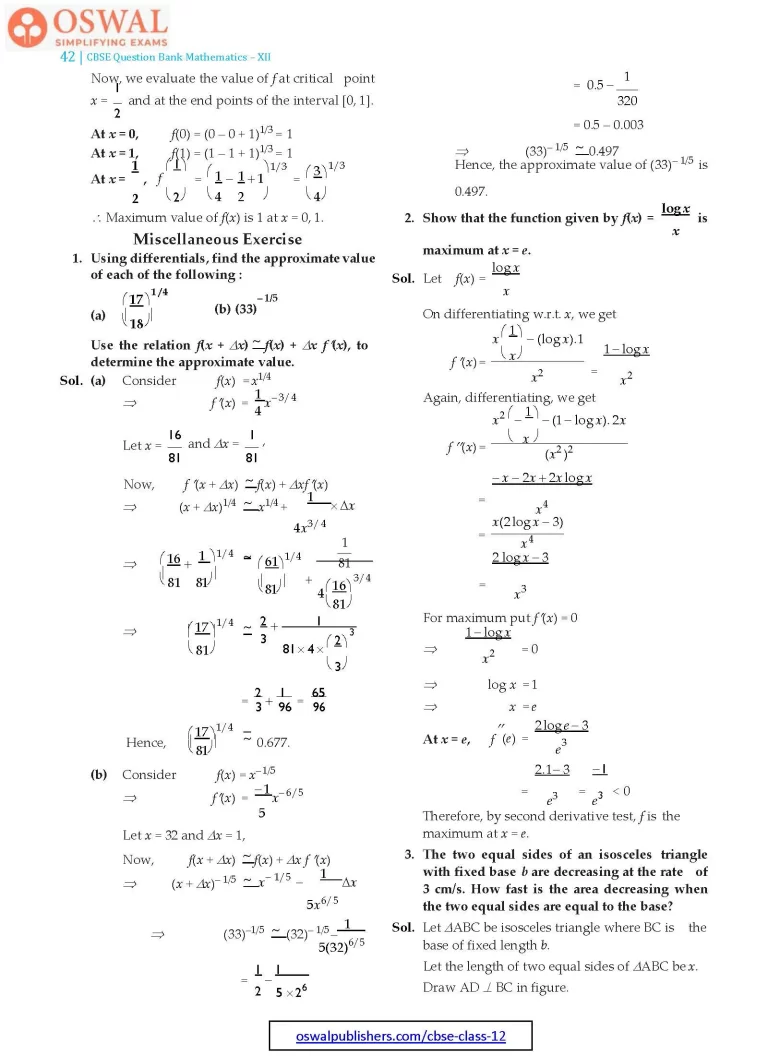

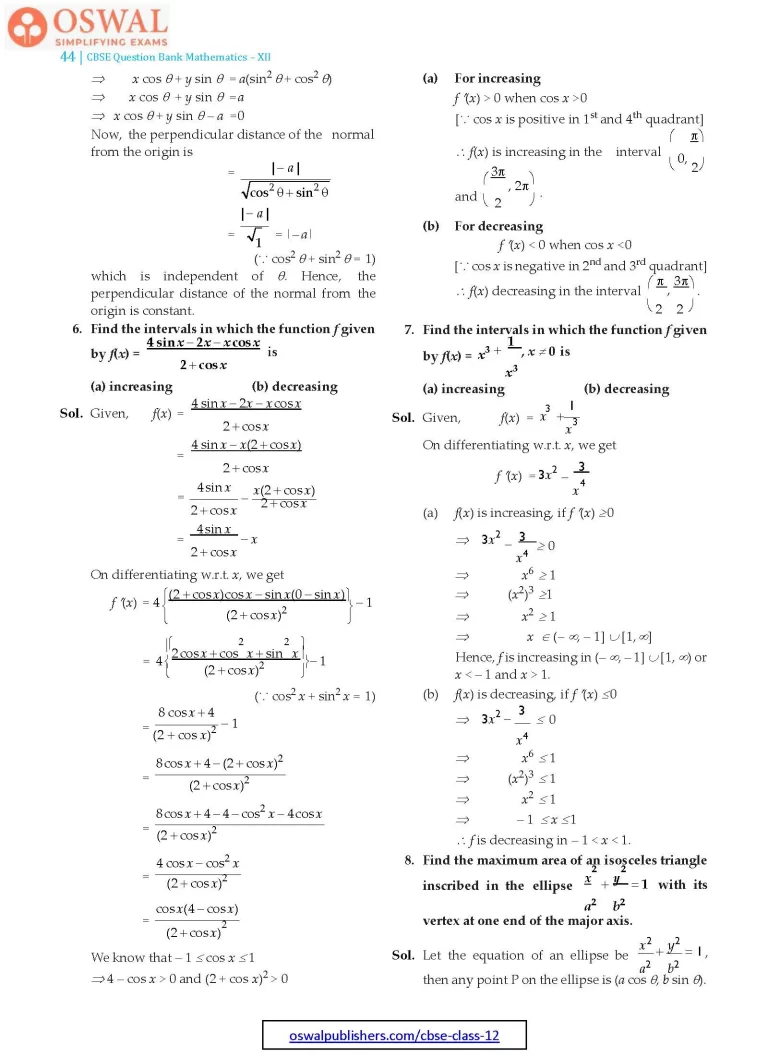
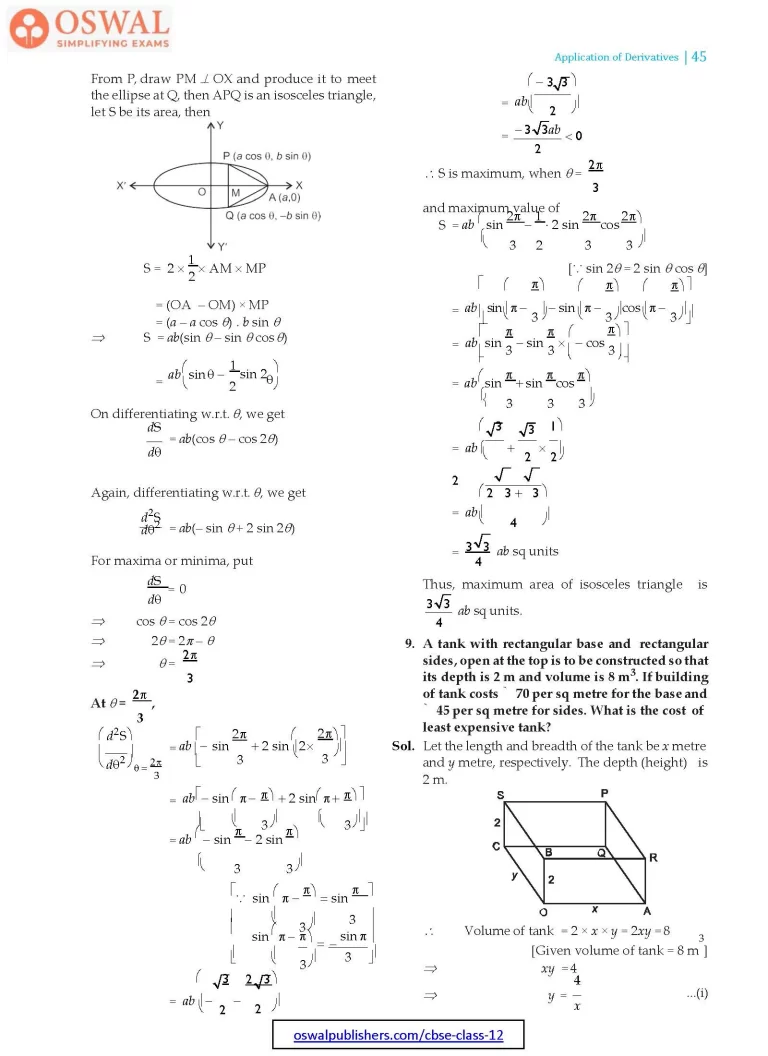
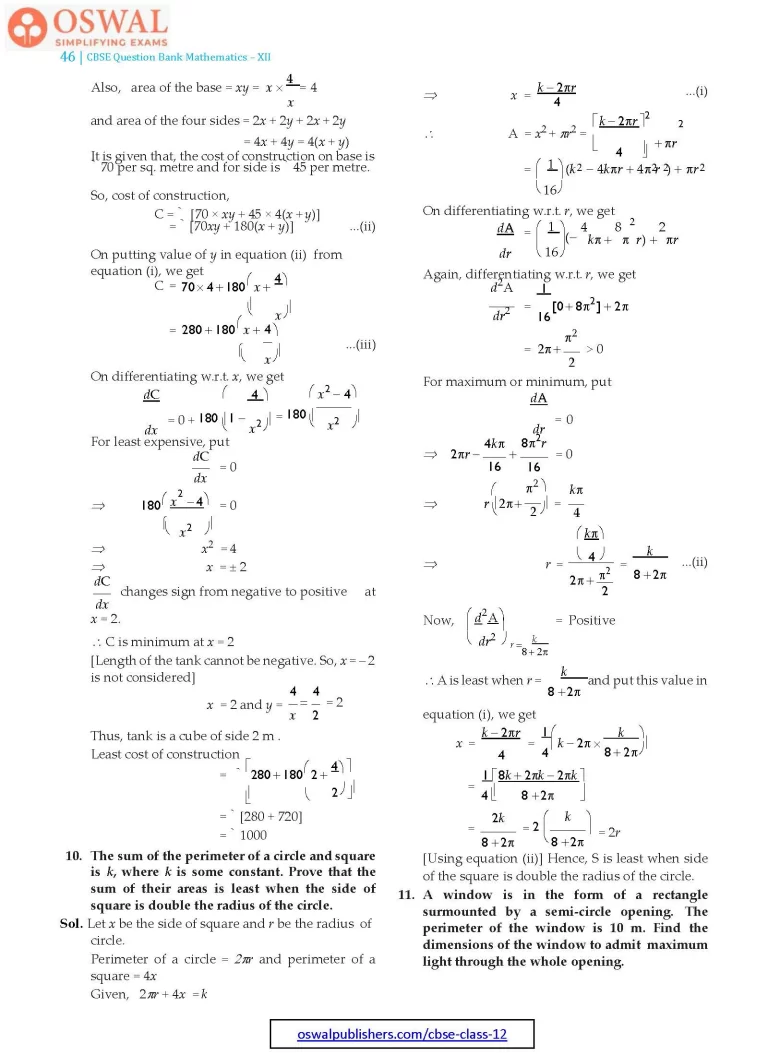
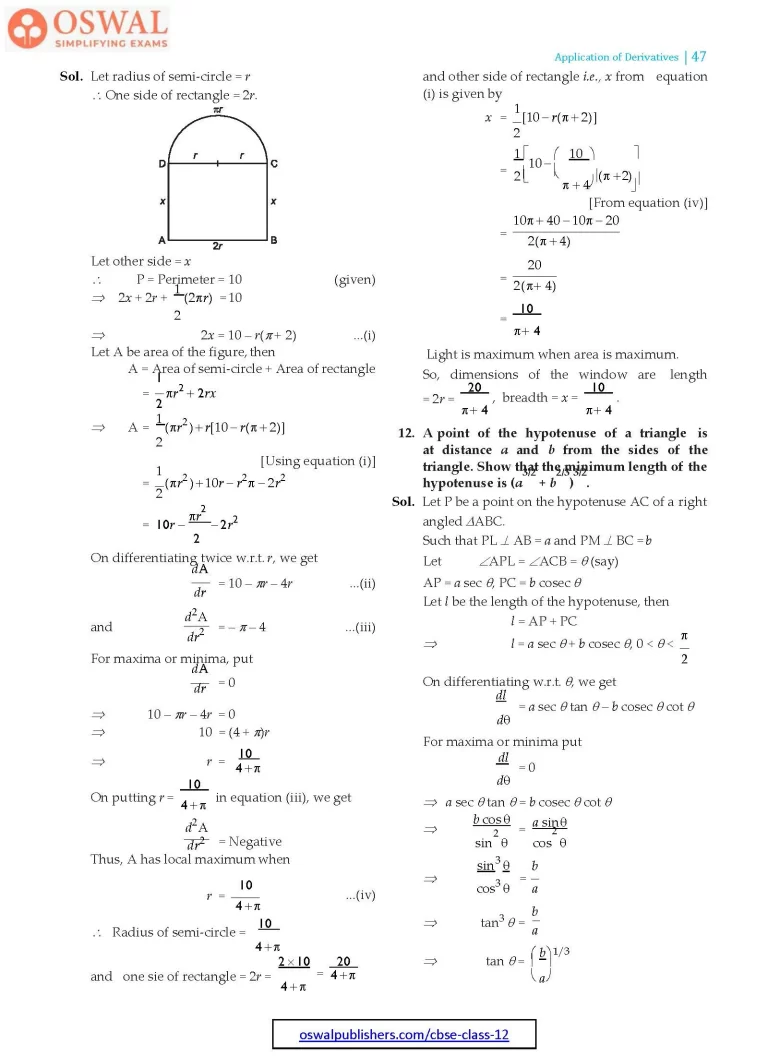
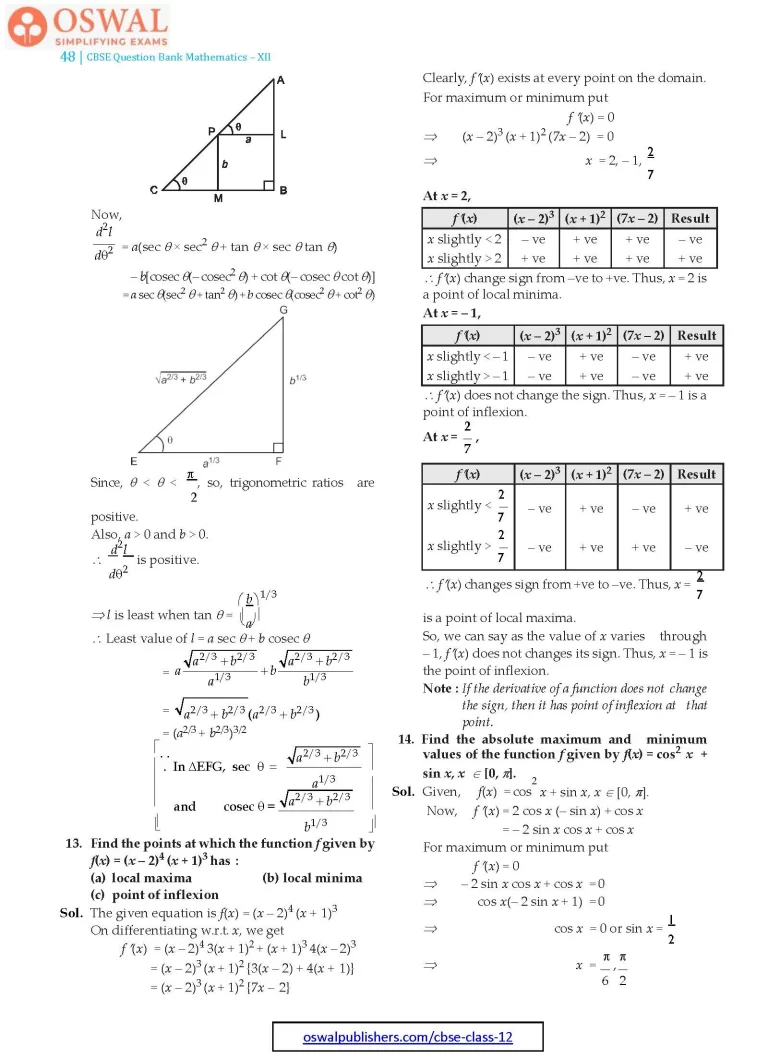
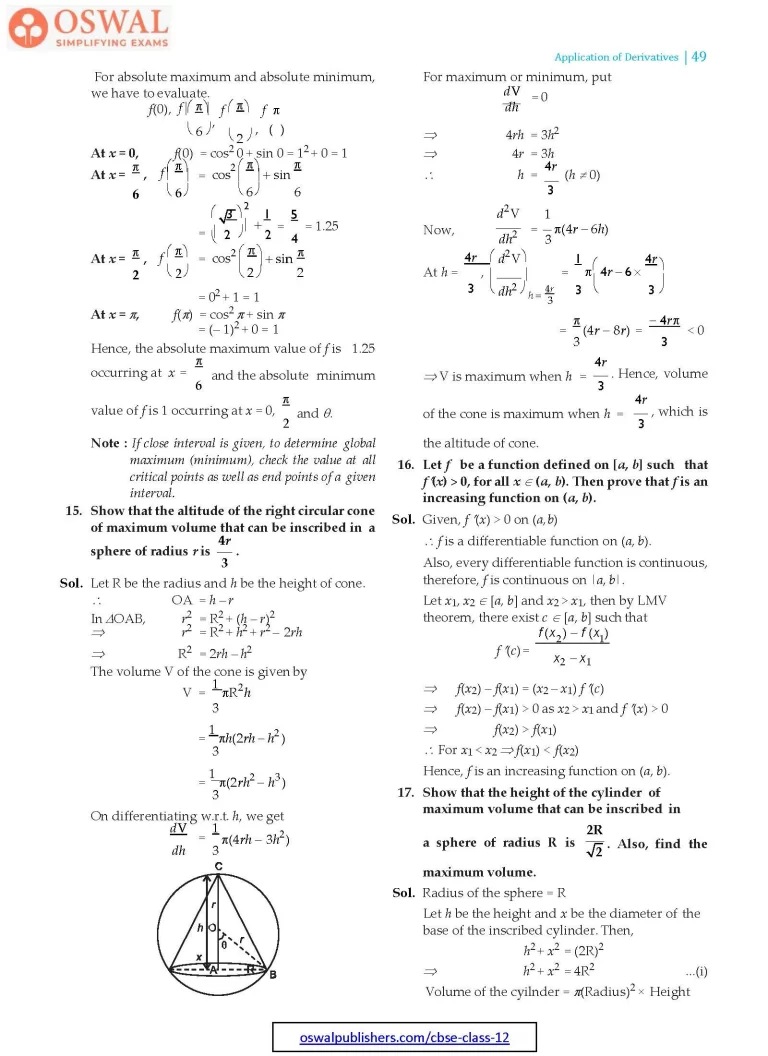
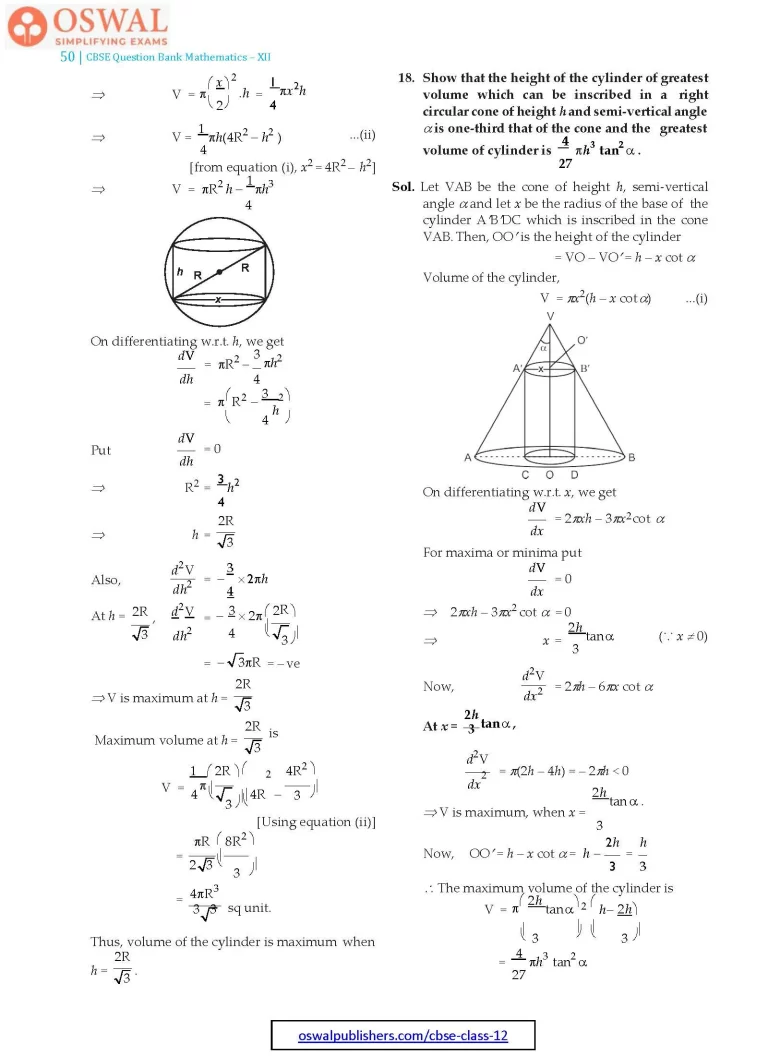
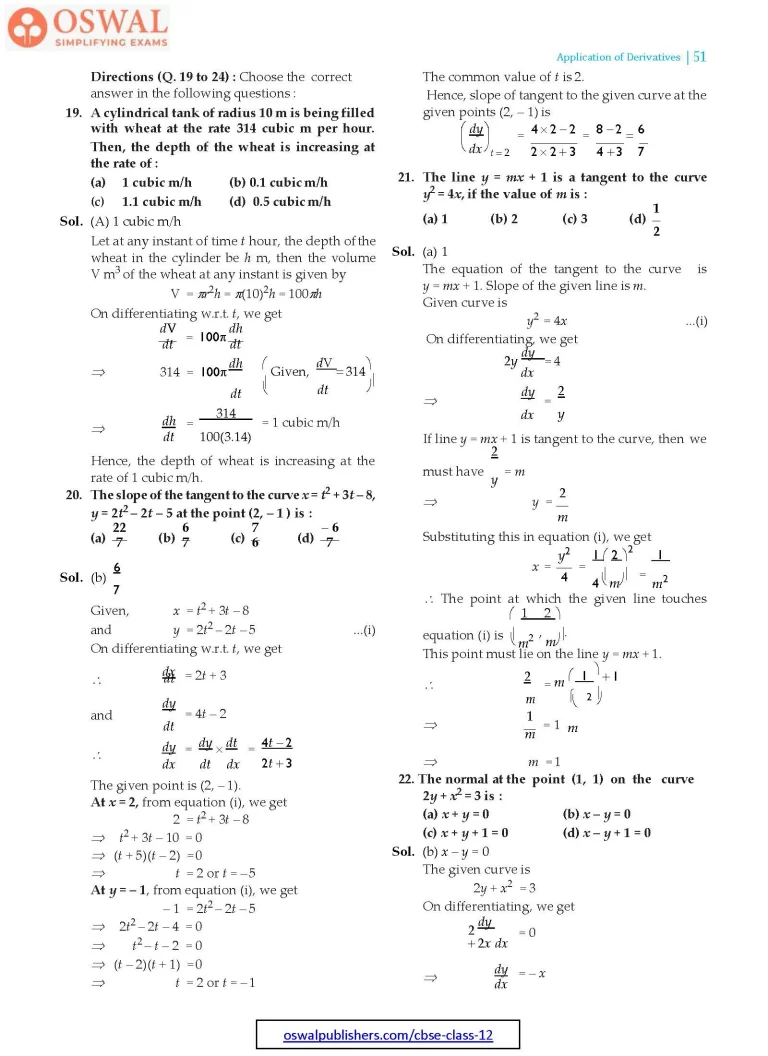
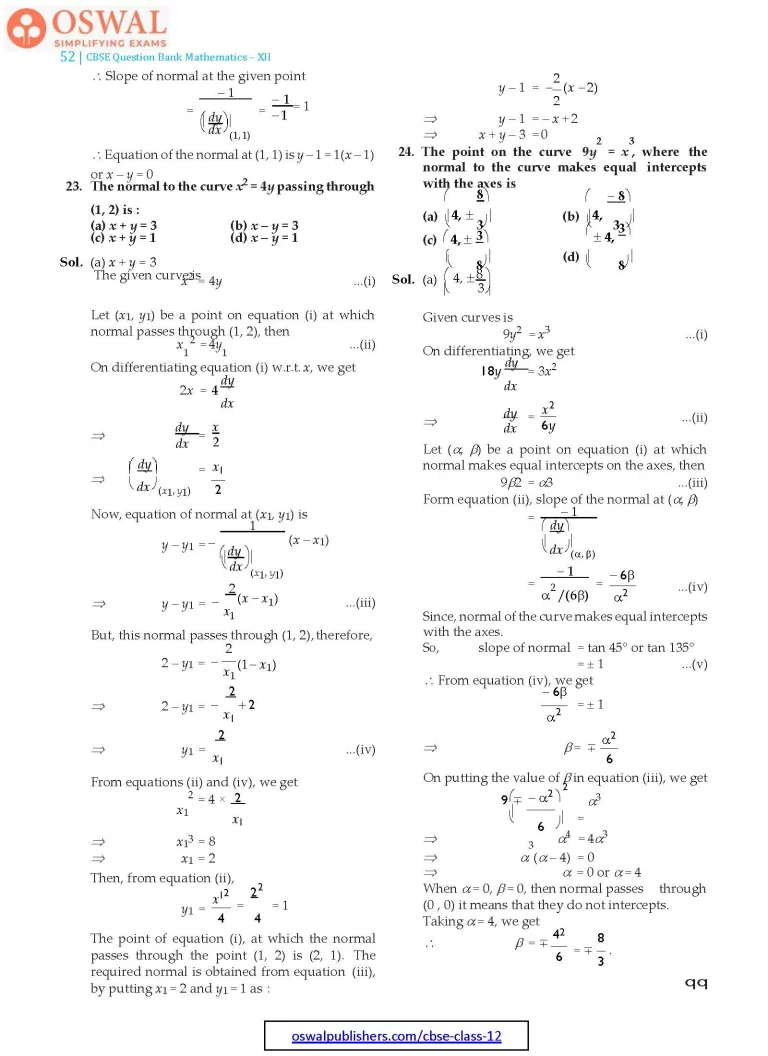
Access Exercises of Class 12 Maths Chapter 6 Application of Derivatives
Exercise 6.1 Solutions: 18 Questions (10 Long, 6 Short, 2 MCQs)
Exercise 6.2 Solutions: 19 Questions (10 Long, 7 Short, 2 MCQs)
Exercise 6.3 Solutions: 27 Questions (14 Long, 11 Short, 2 MCQs)
Exercise 6.4 Solutions: 9 Questions (7 Short, 2 MCQs)
Exercise 6.5 Solutions: 29 Questions (15 Long, 11 Short, 3 MCQs)
Miscellaneous Exercise Solutions: 24 Questions (14 Long, 4 Short, 6 MCQs)
Miscellaneous Exercise
1. Using differentials, find the approximate value of each of the following :
$$\textbf{(a)}\space\bigg(\frac{\textbf{17}}{\textbf{18}}\bigg)^{\textbf{1/4}}\\\textbf{(b)\space}(\textbf{33})^{\textbf{-1/5}}$$
$$\textbf{Use the relation}\\\space f(\textbf{x+}\Delta \textbf{x})\simeq\textbf{f(x) +} \Delta \textbf{x f ′(x),}\\\textbf{to determine the approximate value.}$$
Sol. (a) Consider f(x) = x1/4
$$\Rarr\space f'(x)=\frac{1}{4}x^{-3/4}\\\text{Let x =}\frac{16}{81}\space\text{and}\space\Delta x=\frac{1}{81},$$
$$\text{Now,}\space f(x+\Delta x)\simeq f(x)+\Delta xf'(x)\\\Rarr\space (x+\Delta x)^{1/4}\simeq x^{1/4}+\frac{1}{4x^{3/4}}×\Delta x\\\Rarr\space\bigg(\frac{16}{81}+\frac{1}{81}\bigg)^{1/4}\\\simeq\bigg(\frac{61}{81}\bigg)^{1/4}+\frac{\frac{1}{81}}{4\bigg(\frac{16}{81}\bigg)^{\normalsize 3/4}}\\\Rarr\space\bigg(\frac{17}{81}\bigg)^{1/4}\simeq\frac{2}{3}+\frac{1}{81×4×\bigg(\frac{2}{3}\bigg)^3}\\=\frac{2}{3}+\frac{1}{96}=\frac{65}{96}$$
$$\text{Hence,\space}\bigg(\frac{17}{81}\bigg)^{1/4}\simeq\space 0.677.$$
(b) Consider f(x) = x– 1/5
$$\Rarr\space f'(x)=\frac{\normalsize-1}{5}x^{-6/5}$$
Let x = 32 and Δx = 1,
$$\text{Now,}\space f(x+\Delta x)\simeq f(x)+\Delta f'(x)\\\Rarr\space (x+\Delta x)^{\normalsize-1/5}\simeq x^{\normalsize-1/5}-\frac{1}{5x^{6/5}}\Delta x\\\Rarr\space (33)^{-1/5}\simeq(32)^{-1/5}-\frac{1}{5(32)^{6/5}}\\=\frac{1}{2}-\frac{1}{5×2^6}\\=0.5-\frac{1}{320}$$
= 0.5 – 0.003
$$\Rarr\space (33)^{-1/5}\simeq 0.497$$
Hence, the approximate value of (33)– 1/5 is 0.497.
2. Show that the function given by
$$\textbf{f(x)}=\frac{\textbf{log x}}{\textbf{x}}\space\textbf{is maximum at x = e.}$$
$$\textbf{Sol.\space}\text{Let f(x) =}\frac{\text{log x}}{x}$$
On differentiating w.r.t.x, we get
$$f'(x)=\frac{x\bigg(\frac{1}{x}\bigg)-\text{(log x).1}}{x^2}\\=\frac{1- log x}{x^2}$$
Again, differentiating, we get
$$f''(x)=\frac{x^2\bigg(-\frac{1}{x}\bigg)-(1- log x).2x}{(x^2)^2}\\=\frac{-x-2x+2x log x}{x^4}\\=\frac{x(2 logx-3)}{x^4}\\=\frac{2 log x-3}{x^3}$$
For maximum put f ′(x) = 0
$$\Rarr\space\frac{1- log x}{x^2}=0$$
⇒ log x = 1
⇒ x = e
$$\text{At x=e,}\space f''(e)=\frac{2 log e-3}{e^3}\\=\frac{2.1-3}{e^3}=\frac{-1}{e^3}\lt 0$$
Therefore, by second derivative test, f is the maximum at x = e.
3. The two equal sides of an isosceles triangle with fixed base b are decreasing at the rate of 3 cm/s. How fast is the area decreasing when the two equal sides are equal to the base?
Sol. Let ΔABC be isosceles triangle where BC is the base of fixed length b.
Let the length of two equal sides of ΔABC be x.
Draw AD ⊥ BC in figure.

Now , in ΔABD, by applying the Pythagoras theorem, we have
$$\text{AD}=\sqrt{x^2-\bigg(\frac{b}{2}\bigg)^2}\\=\sqrt{x^2-\frac{b^2}{4}}\\\therefore\space\text{Area of triangle (A) =}\\\frac{1}{2}×\text{Base × Height}\\=\frac{b}{2}\sqrt{x^2-\frac{b^2}{4}}$$
The rate of change of the area A w.r.t. time t is given by
$$\frac{dA}{dt}=\frac{1}{2}b×\frac{1}{2}\frac{2x}{\sqrt{x^2-\frac{b^2}{4}}}×\frac{dx}{dt}\\=\frac{xb}{\sqrt{4x^2-b^2}}\frac{dx}{dt}$$
It is given that the two equal sides of the triangle are decreasing at the rate of 3 cm/s.
$$\therefore\space\frac{dx}{dt}=-3\space\text{cm/s}$$
(Negative sign use for decreasing)
$$\therefore\space\frac{dA}{dt}=\frac{-3xb}{\sqrt{4x^2-b^2}}\space\text{cm}^2/s\\\text{When x = b, we have}\\\frac{dA}{dt}=\frac{-3b^2}{\sqrt{3b^2}}=-\sqrt{3b}\space\text{cm}^2/s$$
Hence, if the two equal sides are equal to the base, then the area of the triangle is decreasing at the rate of
$$\sqrt{3}b\space\text{cm}^2/s.$$
Note : If the rate of change is increasing, we take positive sign and if the rate of change is decreasing, we take negative sign.
4. Find the equation of the normal to curve y2 = 4x which passes through the point (1, 2).
Sol. The equation of the given curve is y2 = 4x.
On differentiating w.r.t. x, we get
$$2y\frac{dy}{dx}=4\\\Rarr\space \frac{dy}{dx}=\frac{4}{2y}=\frac{2}{y}\\\therefore\space\text{Slope of tangent at (1, 2), is}\\\bigg(\frac{dy}{dx}\bigg)_{(1,2)}=\frac{2}{2}=1\\\text{Slope of normal at the point (1, 2) =}\\-\frac{1}{1}=-1$$
∴ Equation of the normal at (1, 2) is
y – 2 = – 1(x – 1)
⇒ y – 2 = – x + 1
⇒ x + y – 3 = 0
5. Show that the normal at any point θ to the curve x = a cos θ + a θ sin θ, y = a sin θ – a θ cos θ is at a constant distance from the origin.
Sol. The given curve is
x = a cos θ + a θ sin θ
y = a sin θ – a θ cos θ
On differentating w.r.t. θ, we get
$$\frac{dx}{d\theta}=-a\space\text{sin}\theta+a[\theta\space\text{cos}\theta + \text{sin}\theta]$$
= – a sin θ + aθ cos θ + a sin θ
= a θ cos θ
∴ Slope of the tangent at θ,
$$\frac{dy}{dx}=\frac{dy}{d\theta}×\frac{d\theta}{dx}\\=\frac{a\space\theta\text{sin}\theta}{a\space\theta\text{cos}\theta}=\text{tan}\theta\\\text{Slope of the normal at}\theta\\=-\frac{1}{\frac{dy}{dx}}\\=-\frac{1}{\text{tan}\space\theta}$$
= – cot θ
The equation of the normal at a given point (x, y) is given by
y – [a sin θ – aq cos θ]
= – cot θ[x – (a cos θ + aθ sin θ)]
⇒ y – [a sin θ – aθ cos θ]
$$=-\frac{\text{cos}\theta}{\text{sin}\theta}\space[x-(a \text{cos}\space\theta + a\theta \space\text{sin}\space\theta)]$$
⇒ y sin θ – a sin2 θ + aθ sin θ cos θ
= – x cos θ + a cos2 θ + aθ sin θ cos θ
⇒ x cos θ + y sin θ = a(sin2 θ + cos2 θ)
⇒ x cos θ + y sin θ = a
⇒ x cos θ + y sin θ – a = 0
Now , the perpendicular distance of the normal from the origin is
$$=\frac{|-a|}{\sqrt{\text{cos}^2\theta + \text{sin}^2\theta}}\\=\frac{|-a|}{\sqrt{1}}=|-a|$$
(∵ cos2 θ + sin2 θ = 1)
which is independent of θ. Hence, the perpendicular distance of the normal from the origin is constant.
6. Find the intervals in which the function f given by
$$\textbf{f(x)=}\frac{\textbf{4} \space\textbf{sin}\textbf{x- 2x-x} \textbf{cos x}}{\textbf{2+}\textbf{cos x}}\space\textbf{is}$$
(a) increasing
(b) decreasing
$$\textbf{Sol.}\space\text{Given,}\space f(x)=\frac{4\space\text{sin x}-2x-x\text{cos}x}{2+\text{cos x}}\\=\frac{4 \space\text{sin x}-x(2+\text{cos x})}{2+\text{cos x}}\\=\frac{4\space\text{sin x}}{2+\text{cos x}}-\frac{x(2+\text{cos x})}{2+\text{cos x}}\\=\frac{4 \text{sin x}}{2 + \text{cos x}}-x$$
On differentiating w.r.t. x, we get
$$f'(x)=4\begin{Bmatrix}\frac{(2+\text{cos x})\text{cos x}-\text{sin x}(0-\text{sin x})}{(2+\text{cos x})^2}\end{Bmatrix}-1\\=4\begin{Bmatrix}\frac{2\text{cos x}+\text{cos}^2x+\text{sin}^2x}{(2+\text{cos x})^2}\end{Bmatrix}-1\\(\because\space \text{cos}^2x+\text{sin}^2x=1)\\=\frac{8\space\text{cos x}+4}{(2+\text{cos x})^2}-1\\=\frac{8\space\text{cos x+4-(2+\text{cos x})}^2}{(2+\text{cos x})^2}\\=\frac{8 \space \text{cos x}+4-4-\text{cos}^2x-4\text{cos x}}{(2+\text{cos x})^2}\\=\frac{4 \text{cos x}-\text{cos}^2x}{(2+\text{cos x})^2}\\=\frac{\text{cos x(4-\text{cos x})}}{(2+\text{cos x})^2}$$
We know that – 1 ≤ cos x ≤ 1
⇒ 4 – cos x > 0 and (2 + cos x)2 > 0
(a) For increasing
f ′(x) > 0 when cos x > 0
[∵ cos x is positive in 1st and 4th quadrant]
$$\therefore\space\text{f(x) is increasing in the interval}\\\space\bigg(0,\frac{\pi}{2}\bigg)\space\text{and}\space\bigg(\frac{3\pi}{2},2\pi\bigg).$$
(b) For decreasing
f ′(x) < 0 when cos x < 0
[∵ cos x is negative in 2nd and 3rd quadrant]
$$\therefore\space\text{f(x) decreasing in the interval}\\\bigg(\frac{\pi}{2},\frac{3\pi}{2}\bigg).$$
7. Find the intervals in which the function f given by
$$\textbf{f(x)=x}^\textbf{3}\textbf{+}\frac{\textbf{1}}{\textbf{x}^\textbf{3}},\textbf{x} \neq 0 \space\textbf{is}$$
(a) increasing
(b) decreasing
$$\textbf{Sol.}\space\text{Given}\space \text{f(x)}=x^3+\frac{1}{x^3}\\\text{On differentiating w.r.t. x, we get}\\\text{f ′(x) = 3x}^2-\frac{3}{x^4}$$
(a) f(x) is increasing, if f ′(x) ≥ 0
$$\Rarr\space 3x^2-\frac{3}{x^4}\geq0$$
⇒ x6 ≥ 1
⇒ (x2)3 ≥1
⇒ x2 ≥ 1
⇒ x ∈ (– ∞, – 1] ∪ [1, ∞]
Hence, f is increasing in (– ∞, – 1] ∪ [1, ∞) or
x < – 1 and x > 1.
(b) f(x) is decreasing, if f ′(x) ≤ 0
$$\Rarr\space 3x^2-\frac{3}{x^4}\leq 0$$
⇒ x6 ≤ 1
⇒ (x2)3 ≤ 1
⇒ x2 ≤ 1
⇒ – 1 ≤ x ≤ 1
∴ f is decreasing in – 1 < x < 1.
8. Find the maximum area of an isosceles triangle inscribed in the ellipse
$$\frac{\textbf{x}^2}{\textbf{a}^2}+\frac{\textbf{y}^2}{\textbf{b}^2}\textbf{= 1}\\\textbf{with its vertex at one end}\\\textbf{of the major axis.}$$
Sol. Let the equation of an ellipse be
$$\frac{x^2}{a^2}+\frac{y^2}{b^2}=1,$$
then any point P on the ellipse is (a cos θ, b sin θ).
From P , draw PM ⊥ OX and produce it to meet the ellipse at Q, then APQ is an isosceles triangle, let S be its area, then

$$\text{S}=2×\frac{1}{2}×\text{AM×MP}$$
= (OA – OM) × MP
= (a – a cos θ) . b sin θ
⇒ S = ab(sin θ – sin θ cos θ)
$$=ab\bigg(\text{sin}\space\theta-\frac{1}{2}\space\text{sin}2\theta\bigg)$$
On differentiating w.r.t. θ, we get
$$\frac{dS}{d\theta}=ab(\text{cos}\theta-\text{cos} 2\theta)$$
Again, differentiating w.r.t. θ, we get
$$\frac{d^2S}{d\theta^2}=ab(-\text{sin}\space\theta + 2 \text{sin}2\theta)$$
For maxima or minima, put
$$\frac{dS}{d\theta}=0$$
⇒ cos θ = cos 2θ
⇒ 2θ = 2π – θ
$$\Rarr\space \theta=\frac{2\pi}{3}$$
$$\text{At}\theta=\frac{2\pi}{3},\\\bigg(\frac{d^2S}{d\theta^2}\bigg)_{\theta=\frac{2\pi}{3}}\\=ab\bigg[-\text{sin}\frac{2\pi}{3}+2\text{sin}\bigg(2×\frac{2\pi}{3}\bigg)\bigg]\\=ab\bigg[-\text{sin}\bigg(\pi-\frac{\pi}{3}\bigg)+2 \text{sin}\bigg(\pi+\frac{\pi}{3}\bigg)\bigg]\\=ab\bigg(-\text{sin}\frac{\pi}{3}-2\text{sin}\frac{\pi}{3}\bigg)\\\begin{bmatrix}\because\space \text{sin}\bigg(\pi-\frac{\pi}{3}\bigg)=\text{sin}\frac{\pi}{3}\\\text{sin}\bigg(\pi-\frac{\pi}{3}\bigg)=\frac{-\text{sin}\pi}{3}\end{bmatrix}$$
$$= ab\bigg(-\frac{\sqrt{3}}{2}-\frac{2\sqrt{3}}{2}\bigg)\\=ab\bigg(\frac{-3\sqrt{3}}{2}\bigg)\\=\frac{-3\sqrt{3}ab}{2}\lt 0\\\therefore\space\text{S is maximum, when}\space\theta=\frac{2\pi}{3}\\\text{and maximum value of}\\\text{S = ab}\bigg(\text{sin}\frac{2\pi}{3}-\frac{1}{2}.\text{2 sin}\frac{2\pi}{3}\text{cos}\frac{2\pi}{3}\bigg)$$
[∵ sin 2θ = 2 sin θ cos θ]
$$=ab\bigg[\text{sin}\bigg(\pi-\frac{\pi}{3}\bigg)-\text{sin}\bigg(\pi-\frac{\pi}{3}\bigg)\text{cos}\bigg(\pi-\frac{\pi}{3}\bigg)\bigg]\\=ab\bigg[\text{sin}\frac{\pi}{3}-\text{sin}\frac{\pi}{3}×\bigg(-\text{cos}\frac{\pi}{3}\bigg)\bigg]\\=ab\bigg(\text{sin}\frac{\pi}{3}+\text{sin}\frac{\pi}{3}\text{cos}\frac{\pi}{3}\bigg)\\=ab\bigg(\frac{\sqrt{3}}{2}+\frac{\sqrt{3}}{2}×\frac{1}{2}\bigg)\\=ab\bigg(\frac{2\sqrt{3}+\sqrt{3}}{4}\bigg)\\=\frac{3\sqrt{3}}{4}\space\text{ab sq units}$$
Thus, maximum area of isosceles triangle
is
$$\frac{3\sqrt{3}}{4}\space\text{ab sq units.}$$
9. A tank with rectangular base and rectangular sides, open at the top is to be constructed so that its depth is 2 m and volume is 8 m3. If building of tank costs ₹ 70 per sq metre for the base and ₹45 per sq metre for sides. What is the cost of least expensive tank?
Sol. Let the length and breadth of the tank be x metre and y metre, respectively. The depth (height) is 2 m.

∴ Volume of tank = 2 × x × y = 2xy = 8
[Given volume of tank = 8 m3]
⇒ xy = 4
$$\Rarr\space y=\frac{4}{x}\space\text{...(i)}\\\text{Also, area of the base}\\=xy=x×\frac{4}{x}=4$$
and area of the four sides = 2x + 2y + 2x + 2y
= 4x + 4y = 4(x + y)
It is given that, the cost of construction on base is ₹ 70 per sq. metre and for side is ₹ 45 per metre.
So, cost of construction,
C = ₹ [70 × xy + 45 × 4(x + y)]
= ₹ [70xy + 180(x + y)] ...(ii)
On putting value of y in equation (ii) from equation (i), we get
$$\text{C}= 70×4+180\bigg(x+\frac{4}{x}\bigg)\\=280+180\bigg(x+\frac{4}{x}\bigg)\space\text{...(iii)}$$
On differentiating w.r.t. x, we get
$$\frac{dC}{dx}=0+180\bigg(1-\frac{4}{x^2}\bigg)\\=180\bigg(\frac{x^2-4}{x^2}\bigg)$$
For least expensive, put
$$\frac{dC}{dx}=0\\\Rarr\space 180\bigg(\frac{x^2-4}{x^2}\bigg)=0$$
⇒ x2 = 4
⇒ x = ± 2
$$\frac{dC}{dx}\space\text{changes sign from negative}\\\text{to positive at x = 2.}$$
∴ C is minimum at x = 2
[Length of the tank cannot be negative. So, x = – 2 is not considered]
$$x = 2\space\text{and}\space y=\frac{4}{x}=\frac{4}{2}=2$$
Thus, tank is a cube of side 2 m .
Least cost of construction
$$= ₹\bigg[280+180\bigg(2+\frac{4}{2}\bigg)\bigg]$$
= ₹[280 + 720]
= ₹ 1000
10. The sum of the perimeter of a circle and square is k, where k is some constant. Prove that the sum of their areas is least when the side of square is double the radius of the circle.
Sol. Let x be the side of square and r be the radius of circle.
Perimeter of a circle = 2πr and perimeter of a square = 4x
Given, 2πr + 4x = k
$$\Rarr\space x=\frac{k-2\pi r}{4}\space\text{...(i)}\\\therefore\space A=x^2+\pi r^2\\=\bigg[\frac{k-2\pi r}{4}\bigg]^2+\pi r^2\\=\bigg(\frac{1}{16}\bigg)(k^2-4\pi r+4\pi^2r^2)+\pi r^2$$
On differentiating w.r.t. r, we get
$$\frac{dA}{dr}=\bigg(\frac{1}{16}\bigg)(-4k\pi+8\pi^2r)+2\pi r$$
Again, differentiating w.r.t. r, we get
$$\frac{d^2A}{dr^2}=\frac{1}{16}[0+8\pi^2]+2\pi\\=2\pi+\frac{\pi^2}{2}\gt0$$
For maximum or minimum, put
$$\frac{dA}{dr}=0\\\Rarr\space 2\pi r-\frac{4k\pi}{16}+\frac{8\pi^2 r}{16}=0\\\Rarr\space r\bigg(2\pi+\frac{\pi^2}{2}\bigg)=\frac{k\pi}{4}\\\Rarr\space r=\frac{\bigg(\frac{k\pi}{4}\bigg)}{2\pi+\frac{\pi^2}{2}}=\frac{k}{8+2\pi}\space\text{...(ii)}\\\text{Now,}\space \bigg(\frac{d^2A}{dr^2}\bigg)_{r=\frac{k}{8+2\pi}}=\text{Positive}\\\therefore\space\text{A is least when r =}\frac{k}{8+2\pi}$$
and put this value in equation (i), we get
$$x=\frac{k-2\pi r}{4}\\=\frac{1}{4}\space\bigg(k-2\pi×\frac{k}{8+2\pi}\bigg)\\=\frac{1}{4}\bigg[\frac{8k+2\pi k-2\pi k}{8+2\pi}\bigg]\\=\frac{2k}{8+2\pi}=2\bigg(\frac{k}{8+2\pi}\bigg)=2r$$
[Using equation (ii)]
Hence, S is least when side of the square is double the radius of the circle.
11. A window is in the form of a rectangle surmounted by a semi-circle opening. The perimeter of the window is 10 m. Find the dimensions of the window to admit maximum light through the whole opening.
Sol. Let radius of semi-circle = r
∴ One side of rectangle = 2r.

Let other side = x
∴ P = Perimeter = 10 (given)
$$\Rarr\space 2x+2r+\frac{1}{2}(2\pi r)=10$$
⇒ 2x = 10 – r(π + 2) ...(i)
Let A be area of the figure, then
A = Area of semi-circle + Area of rectangle
$$=\frac{1}{2}\pi r^2+2rx\\\Rarr\space A=\frac{1}{2}(\pi r^2)+r[10-r(\pi+2)]\\\text{[Using equation (i)]}\\=\frac{1}{2}(\pi r^2)+10r-r^2\pi-2r^2\\= 10r-\frac{\pi r^2}{2}-2r^2$$
On differentiating twice w.r.t. r, we get
$$\frac{dA}{dr}=10-\pi r-4r\space\text{...(ii)}\\\text{and}\space\frac{d^2A}{dx^2}=-\pi-4\space \text{...(iii)}$$
For maxima or minima, put
$$\frac{dA}{dr}=0$$
⇒ 10 – πr – 4r = 0
⇒ 10 = (4 + π)r
$$\Rarr\space r=\frac{10}{4+\pi}\\\text{On putting r = }\frac{10}{4+\pi}\space\text{in equation (iii), we get}\\\frac{d^2A}{dr^2}=\text{Negative}$$
Thus, A has local maximum when
$$r=\frac{10}{4\pi}\space\text{... (iv)}\\\therefore\space\text{Radius of semi-circle =}\frac{10}{4+\pi}\\\text{and one sie of rectangle = 2r =}\\\frac{2×10}{4+\pi}=\frac{20}{4+\pi}$$
and other side of rectangle i.e., x from equation (i) is given by
$$x=\frac{1}{2}[10-r(\pi +2)]\\=\frac{1}{2}\bigg[10-\bigg(\frac{10}{\pi+4}(\pi+2)\bigg)\bigg]\\\text{[From equation (iv)]}\\=\frac{10\pi+40-10\pi-20}{2(\pi+4)}\\=\frac{20}{2(\pi+4)}\\=\frac{10}{\pi+4}$$
Light is maximum when area is maximum.
So, dimensions of the window are length
$$= 2r=\frac{20}{\pi+4},\text{breadth}=x=\frac{10}{\pi+4}.$$
12. A point of the hypotenuse of a triangle is at distance a and b from the sides of the triangle. Show that the minimum length of the hypotenuse is (a3/2 + b2/3)3/2.
Sol. Let P be a point on the hypotenuse AC of a right angled ΔABC.
Such that PL ⊥ AB = a and PM ⊥ BC = b
Let ∠APL = ∠ACB = θ (say)
AP = a sec θ, PC = b cosec θ
Let l be the length of the hypotenuse, then
l = AP + PC
$$\Rarr\space\text{l = a sec} \theta + b\space \text{cosec}\space\theta, 0 < \theta\lt\frac{\pi}{2}$$
On differentiating w.r.t. θ, we get
$$\frac{dl}{d\theta}=a\space\text{sec}\space\theta\text{tan}\theta-b\space\text{cosec}\theta\text{cot}\theta$$
For maxima or minima put
$$\frac{dl}{d\theta}=0$$
⇒ a sec θ tan θ = b cosec θ cot θ
$$\Rarr\space\frac{b\space\text{cos}\space\theta}{\text{sin}^2\theta}=\frac{\text{a sin}\theta}{\text{cos}^2\theta}\\\Rarr\space\frac{\text{sin}^3\theta}{\text{cos}^3\theta}=\frac{b}{a}\\\Rarr\space\text{tan}^3\theta=\frac{b}{a}\\\Rarr\space\text{tan}\space\theta=\bigg(\frac{b}{a}\bigg)^{1/3}$$

Now ,
$$\frac{d^2l}{d\theta^2}=\text{a(sec}\space\theta×\text{sec}^2\theta+\text{tan}\theta×\text{sec}\theta\text{tan}\theta)\\-b[\text{cosec}\theta(-\text{cosec}^2\theta)+\text{cot}\space\theta(-\text{cosec}\theta\space\text{cot}\space\theta)]\\= a\space\text{sec}\space\theta(\text{sec}^2\theta+\text{tan}^2\theta)+ \\b\space\text{cosec}\theta(\text{cosec}^2\theta+\text{cot}^2\theta)$$

$$\text{Since},\space\theta\lt\theta\lt\frac{\pi}{2},$$ so, trigonometric ratios are positive.
Also, a > 0 and b > 0.
$$\therefore\space\frac{d^2l}{d\theta^2}\space\text{is positive.}\\\Rarr\space \text{l is least when tan}\space\theta=\bigg(\frac{b}{a}\bigg)^{1/3}$$
∴ Least value of l = a sec θ + b cosec θ
$$=a\frac{\sqrt{a^{2/3}+b^{2/3}}}{a^{1/3}}+b\frac{\sqrt{a^{2/3}+b^{2/3}}}{b^{1/3}}\\=\sqrt{a^{2/3}+b^{2/3}}(a^{2/3}+b^{2/3})$$
= (a2/3 + b2/3)3/2
$$\begin{bmatrix}\because\space\text{In}\Delta \text{EFG},\text{sec}\space\theta=\frac{\sqrt{a^{2/3}+b^{2/3}}}{a^{1/3}}\\\text{and}\space \text{cosec}\theta=\frac{\sqrt{a^{2/3}+b^{2/3}}}{b^{1/3}}\end{bmatrix}$$
13. Find the points at which the function f given by
f(x) = (x – 2)4 (x + 1)3 has :
(a) local maxima
(b) local minima
(c) point of inflexion
Sol. The given equation is f(x) = (x – 2)4 (x + 1)3
On differentiating w.r.t. x, we get
f ′(x) = (x – 2)4 3(x + 1)2 + (x + 1)3 4(x – 2)3
= (x – 2)3 (x + 1)2 {3(x – 2) + 4(x + 1)}
= (x – 2)3 (x + 1)2 {7x – 2}
Clearly , f ′(x) exists at every point on the domain.
For maximum or minimum put
f ′(x) = 0
⇒ (x – 2)3 (x + 1)2 (7x – 2) = 0
$$\Rarr\space x=2,-1,\frac{2}{7}$$
At x = 2,
| f ′(x) | (x – 2)3 | (x + 1)2 | (7x – 2) | Result |
| $$\text{x \space slightly}\lt 2$$ | – ve | + ve | + ve | - ve |
| $$\text{x \space slightly}\gt 2$$ | + ve | + ve | + ve | + ve |
| f ′(x) | (x – 2)3 | (x + 1)2 | (7x – 2) | Result |
| $$x\space\text{slightly}\lt -1$$ | – ve | + ve | – ve | + ve |
| $$x\space\text{slightly}\gt -1$$ | – ve | + ve | - ve | + ve |
∴ f ′(x) change sign from –ve to +ve. Thus, x = 2 is a point of local minima.
At x = – 1,
∴ f ′(x) does not change the sign. Thus, x = – 1 is a point of inflexion.
$$\textbf{At x = }\frac{2}{7},$$
| f ′(x) | (x – 2)3 | (x + 1)2 | (7x – 2) | Result |
| $$x\space\text{slightly}\lt\frac{2}{7}$$ | – ve | + ve | – ve | + ve |
| $$x\space\text{slightly}\gt\frac{2}{7}$$ | – ve | + ve | + ve | - ve |
$$\therefore\space\text{f ′(x) changes sign from +ve to –ve.}\\\text{Thus x}=\frac{2}{7}.\space\text{is a point of local maxima.}$$
So, we can say as the value of x varies through – 1, f ′(x) does not changes its sign. Thus, x = – 1 is the point of inflexion.
Note : If the derivative of a function does not change the sign, then it has point of inflexion at that point.
14. Find the absolute maximum and minimum values of the function f given by f(x) = cos2 x + sin x, x ∈ [0, π].
Sol. Given, f(x) = cos2 x + sin x, x ∈ [0, π].
Now , f ′(x) = 2 cos x (– sin x) + cos x
= – 2 sin x cos x + cos x
For maximum or minimum put
f ′(x) = 0
⇒ – 2 sin x cos x + cos x = 0
⇒ cos x(– 2 sin x + 1) = 0
$$\Rarr\space \text{cos x = 0 or sin x =}\frac{1}{2}\\\Rarr\space x=\frac{\pi}{6},\frac{\pi}{2}$$
For absolute maximum and absolute minimum, we have to evaluate.
$$f(0),f\bigg(\frac{\pi}{6}\bigg),f\bigg(\frac{\pi}{2}\bigg),f(\pi)$$
At x = 0, f(0) = cos2 0 + sin 0 = 12 + 0 = 1
$$\text{At x}=\frac{\pi}{6},\space f\bigg(\frac{\pi}{6}\bigg)=\text{cos}^2\bigg(\frac{\pi}{6}\bigg)+\text{sin}\frac{\pi}{6}\\=\bigg(\frac{\sqrt{3}}{2}\bigg)^2+\frac{1}{2}=\frac{5}{4}=1.25\\\text{At x=}\frac{\pi}{2},\space f\bigg(\frac{\pi}{2}\bigg)=\text{cos}^2\bigg(\frac{\pi}{2}\bigg)+\text{sin}\frac{\pi}{2}$$
= 02 + 1 = 1
At x = π, f(π) = cos2 π + sin π
= (– 1)2 + 0 = 1
Hence, the absolute maximum value of f is 1.25 occurring
$$\text{at}\space x=\frac{\pi}{6}\space\text{and the absolute minimum}\\\text{value of f is 1 occurring at x = 0,}\frac{\pi}{2}\space\text{and}\space\theta.$$
Note : If close interval is given, to determine global maximum (minimum), check the value at all critical points as well as end points of a given interval.
15. Show that the altitude of the right circular cone of maximum volume that can be inscribed in a sphere of radius r is $$\frac{\textbf{4r}}{\textbf{3}}.$$
Sol. Let R be the radius and h be the height of cone.
∴ OA = h – r
In ΔOAB, r2 = R2 + (h – r)2
⇒ r2 = R2 + h2 + r2 – 2rh
⇒ R2 = 2rh – h2
The volume V of the cone is given by
$$\text{V}=\frac{1}{3}\pi R^2h\\=\frac{1}{3}\pi h(2rh-h^2)\\=\frac{1}{3}\pi(2rh^2-h^3)\\\text{On differentiating w.r.t. h, we get}\\\frac{dV}{dh}=\frac{1}{3}\pi(4rh-3h^2)$$

For maximum or minimum, put
$$\frac{dV}{dh}=0$$
⇒ 4rh = 3h2
⇒ 4r = 3h
$$\therefore\space h=\frac{4r}{3}\space(h\neq 0)\\\text{Now,\space }\frac{d^2V}{dh^2}=\frac{1}{3}\pi(4r-6h)\\\text{At h=}\frac{4r}{3},\space\bigg(\frac{d^2V}{dh^2}\bigg)_{h=\frac{4r}{3}}=\\\frac{1}{3}\pi\bigg(4r-6×\frac{4r}{3}\bigg)\\=\frac{\pi}{3}(4r-8r)=\frac{-4r\pi}{3}\lt 0\\\Rarr\space\text{V is maximum when}\space h=\frac{4r}{3}.\\\text{Hence, volume of the cone is maximum}\\\text{when h =}\frac{4r}{3},\space\text{which is the altitude of cone.}$$
16. Let f be a function defined on [a, b] such that f ′(x) > 0, for all x ∈ (a, b). Then prove that f is an increasing function on (a, b).
Sol. Given, f ′(x) > 0 on (a, b)
∴ f is a differentiable function on (a, b).
Also, every differentiable function is continuous, therefore, f is continuous on |a, b|.
Let x1, x2 ∈ [a, b] and x2 > x1, then by LMV theorem, there exist c ∈ [a, b] such that
$$f'(c)=\frac{f(x_2)-f(x_1)}{x_2-x_1}$$
⇒ f(x2) – f(x1) = (x2 – x1) f ′(c)
⇒ f(x2) – f(x1) > 0 as x2 > x1 and f ′(x) > 0
⇒ f(x2) > f(x1)
∴ For x1 < x2 ⇒ f(x1) < f(x2)
Hence, f is an increasing function on (a, b).
17. Show that the height of the cylinder of maximum volume that can be inscribed in a sphere of radius R is
$$\frac{\textbf{2}\textbf{R}}{\sqrt{\textbf{2}}}.\space\textbf{Also, find the maximum volume.}$$
Sol. Radius of the sphere = R
Let h be the height and x be the diameter of the base of the inscribed cylinder. Then,
h2 + x2 = (2R)2
⇒ h2 + x2 = 4R2 ...(i)
Volume of the cyilnder = π(Radius)2 × Height
$$\Rarr\space \text{V}=\pi\bigg(\frac{x}{2}\bigg)^2.h\\=\frac{1}{4}\pi x^2h\\\Rarr\space\text{V}=\frac{1}{4}\pi h(4 R^2-h^2)\space\text{...(ii)}\\\lbrack\text{from equation (i), x}^2 = 4R^2 – h^2\rbrack\\\Rarr\space \text{V}=\pi R^2h-\frac{1}{4}\pi h^3$$

On differentiating w.r.t. h, we get
$$\frac{dV}{dh}=\pi R^2-\frac{3}{4}\pi h^2\\=\pi\bigg(\text{R}^2-\frac{3}{4}h^2\bigg)\\\text{Put}\space\frac{dV}{dh}=0\\\Rarr\space\text{R}^2=\frac{3}{4}h^2\\\Rarr\space h=\frac{2\text{R}}{\sqrt{3}}\\\text{Also,}\space \frac{d^2V}{dh^2}=-\frac{3}{4}×2\pi h\\\text{At h=}\frac{2R}{\sqrt{3}},\frac{d^2V}{dh^2}=-\frac{3}{4}×2\pi\bigg(\frac{2R}{\sqrt{3}}\bigg)$$
$$=-\sqrt{3}\pi R=-ve\\\Rarr\space\text{V is maximum at h =}\frac{2\text{R}}{\sqrt{3}}\\\text{Maximum volume at h =}\frac{2\text{R}}{\sqrt{3}}\space\text{is}\\\text{V}=\frac{1}{4}\pi\bigg(\frac{2R}{\sqrt{3}}\bigg)\bigg(4R^2-\frac{4R^2}{3}\bigg)\\\text{[Using equation (ii)]}\\=\frac{\pi R}{2\sqrt{3}}\bigg(\frac{8R^2}{3}\bigg)\\=\frac{4\pi R^3}{3\sqrt{3}}\space\text{sq unit.}$$
Thus, volume of the cylinder is maximum when
$$h=\frac{2R}{\sqrt{3}}.$$
18. Show that the height of the cylinder of greatest volume which can be inscribed in a right circular cone of height h and semi-vertical angle a is one-third that of the cone and the greatest
$$\textbf{volume of cylinder is}\space\frac{\textbf{4}}{\textbf{27}}\pi h^3\space\textbf{tan}^2\alpha.$$
Sol. Let VAB be the cone of height h, semi-vertical angle a and let x be the radius of the base of the cylinder A′B′DC which is inscribed in the cone VAB. Then, OO′ is the height of the cylinder
= VO – VO′ = h – x cot α
Volume of the cylinder,
V = πx2(h – x cot α) ...(i)

On differentiating w.r.t. x, we get
$$\frac{dV}{dx}=2\pi xh-3\pi x^2\text{cot}\alpha$$
For maxima or minima put
$$\frac{dV}{dx}=0\\\Rarr\space 2\pi x h-3\pi x^2\space\text{cot}\alpha=0\\\Rarr\space x=\frac{2h}{3}\text{tan}\alpha\space (\because x\neq0)\\\text{Now,}\space\frac{d^2V}{dx^2}=2\pi h-6\pi x\space\text{cot}\alpha\\\text{At x=}\frac{2h}{3}\space\text{tan}\alpha,\\\frac{d^2V}{dx^2}=\pi(2h-4h)=-2\pi h\lt 0\\\Rarr\space\text{V is maximum, when x}=\frac{2h}{3}\text{tan}\alpha.\\\text{Now,\space}OO'= h-x\space\text{cot}\alpha\\ =h-\frac{2h}{3}=\frac{h}{3}$$
Directions (Q. 19 to 24) : Choose the correct answer in the following questions :
19. A cylindrical tank of radius 10 m is being filled with wheat at the rate 314 cubic m per hour. Then, the depth of the wheat is increasing at the rate of :
(a) 1 cubic m/h
(b) 0.1 cubic m/h
(c) 1.1 cubic m/h
(d) 0.5 cubic m/h
Sol. (A) 1 cubic m/h
Let at any instant of time t hour, the depth of the wheat in the cylinder be h m, then the volume V m3 of the wheat at any instant is given by
V = πr2h = π(10)2h = 100πh
On differentiating w.r.t. t, we get
$$\frac{dV}{dt}=100\pi\frac{dh}{dt}\\\Rarr\space 314=100\pi\frac{dh}{dt}\\\bigg(\text{Given}\frac{dV}{dt}=3.14\bigg)\\\Rarr\space\frac{dh}{dt}=\frac{314}{100(3.14)}=1\space\text{cubic\space m/h}$$
Hence, the depth of wheat is increasing at the rate of 1 cubic m/h.
20. The slope of the tangent to the curve x = t2 + 3t – 8, y = 2t2 – 2t – 5 at the point (2, – 1 ) is :
$$\textbf{(a)\space}\frac{\textbf{22}}{\textbf{7}}\\\textbf{(b)\space}\frac{\textbf{6}}{\textbf{7}}\\\textbf{(c)}\space\frac{\textbf{7}}{\textbf{6}}\\\textbf{(d)\space}\frac{\textbf{-6}}{\textbf{7}}\\\textbf{Sol.}\space \text{(b)\space}\frac{6}{7}$$
Given, x = t2 + 3t – 8
and y = 2t2 – 2t – 5 ...(i)
On differentiating w.r.t. t, we get
$$\therefore\space\frac{dx}{dy}=2t-3\\\text{and}\space\frac{dy}{dt}=4t-2\\\therefore\space\frac{dy}{dx}=\frac{dy}{dt}×\frac{dt}{dx}\\=\frac{4t-2}{2t-3}$$
The given point is (2, – 1).
At x = 2, from equation (i), we get
2 = t2 + 3t – 8
⇒ t2 + 3t – 10 = 0
⇒ (t + 5)(t – 2) = 0
⇒ t = 2 or t = – 5
At y = – 1, from equation (i), we get
– 1 = 2t2 – 2t – 5
⇒ 2t2 – 2t – 4 = 0
⇒ t2 – t – 2 = 0
⇒ (t – 2)(t + 1) = 0
⇒ t = 2 or t = – 1
The common value of t is 2.
Hence, slope of tangent to the given curve at the given points (2, – 1) is
$$\bigg(\frac{dy}{dx}\bigg)_{t=2}=\frac{4×2-2}{2×2+3}\\=\frac{8-2}{4+3}=\frac{6}{7}$$
21. The line y = mx + 1 is a tangent to the curve y2 = 4x, if the value of m is :
(a) 1
(b) 2
(c) 3
$$\textbf{(d)\space}\frac{\textbf{1}}{\textbf{2}}$$
Sol. (a) 1
The equation of the tangent to the curve is
y = mx + 1. Slope of the given line is m.
Given curve is
y2 = 4x ...(i)
On differentiating, we get
$$2y\space\frac{dy}{dx}=4\\\Rarr\space\frac{dy}{dx}=\frac{2}{y}$$
If line y = mx + 1 is tangent to the curve,
$$\text{then we must have}\frac{2}{y}=m\\\Rarr\space y=\frac{2}{m}$$
Substituting this in equation (i), we get
$$x=\frac{y^2}{4}=\frac{1}{4}\bigg(\frac{2}{m}\bigg)^2=\frac{1}{m^2}\\\therefore\space\text{The point at which the given line}\\\text{ touches equation (i) is}\space\bigg(\frac{1}{m^2},\frac{2}{m}\bigg).$$
This point must lie on the line y = mx + 1.
$$\therefore\space\frac{2}{m}=m\bigg(\frac{1}{m^2}\bigg)+1\\\Rarr\space\frac{1}{m}=1$$
⇒ m = 1
22. The normal at the point (1, 1) on the curve 2y + x2 = 3 is :
(a) x + y = 0
(b) x – y = 0
(c) x + y + 1 = 0
(d) x – y + 1 = 0
Sol. (b) x – y = 0
The given curve is
2y + x2 = 3
On differentiating, we get
$$2\frac{dy}{dx}+2x=0\\\Rarr\space \frac{dy}{dx}=-x\\\therefore\space\text{Slope of normal at the given point}\\=\frac{-1}{\bigg(\frac{dy}{dx}\bigg)_{(1,1)}}=\frac{-1}{-1}=1$$
∴ Equation of the normal at (1, 1) is y – 1 = 1(x – 1) or x – y = 0
23. The normal to the curve x2 = 4y passing through (1, 2) is :
(a) x + y = 3
(b) x – y = 3
(c) x + y = 1
(d) x – y = 1
Sol. (a) x + y = 3
The given curve is
x2 = 4y ...(i)
Let (x1, y1) be a point on equation (i) at which normal passes through (1, 2), then
x12 = 4y1 ...(ii)
On differentiating equation (i) w.r.t. x, we get
$$2x=4\frac{dy}{dx}\\\Rarr\space \frac{dy}{dx}=\frac{x}{2}\\\Rarr\space\bigg(\frac{dy}{dx}\bigg)_{(x_1,y_1)}=\frac{x_1}{2}$$
Now , equation of normal at (x1, y1) is
$$y-y_1=-\frac{1}{\bigg(\frac{dy}{dx}\bigg)_{(x_1,y_1)}}(x-x_1)\\\Rarr\space y-y_1=-\frac{2}{x_1}(x-x_1)\space\text{...(iii)}$$
But, this normal passes through (1, 2), therefore,
$$2-y_1=-\frac{2}{x_1}(1-x_1)\\\Rarr\space 2-y_1=-\frac{2}{x_1}+2\\\Rarr\space y_1=\frac{2}{x_1}\space\text{...(iv)}\\\text{From equations (ii) and (iv), we get}\\x_1^2=4×\frac{2}{x_1}$$
⇒ x13 = 8
⇒ x1 = 2
Then, from equation (ii),
$$y_1=\frac{x_1^2}{4}=\frac{2^2}{4}=1$$
The point of equation (i), at which the normal passes through the point (1, 2) is (2, 1). The required normal is obtained from equation (iii), by putting x1 = 2 and y1 = 1 as :
$$y-1=-\frac{2}{2} (x-2)$$
⇒ y – 1 = – x + 2
⇒ x + y – 3 = 0
24. The point on the curve 9y2 = x3, where the normal to the curve makes equal intercepts with the axes is
$$\textbf{(a)}\space\bigg(\textbf{4},\pm\space\frac{\textbf{8}}{\textbf{3}}\bigg)\\\textbf{(b)}\space\bigg(\textbf{4},\frac{\textbf{-8}}{\textbf{3}}\bigg)\\\textbf{(c)\space}\bigg(\textbf{4},\pm\frac{\textbf{3}}{\textbf{8}}\bigg)\\\textbf{(d)\space}\bigg(\pm\textbf{4},\frac{\textbf{3}}{\textbf{8}}\bigg)\\\textbf{Sol.}\space \text{(a)}\space\bigg(4,\pm\frac{8}{3}\bigg)$$
Given curves is
9y2 = x3 ...(i)
On differentiating, we get
$$18y\frac{dy}{dx}=3x^2\\\Rarr\space\frac{dy}{dx}=\frac{x^2}{6y}\space\text{...(ii)}$$
Let (α, β) be a point on equation (i) at which normal makes equal intercepts on the axes, then
9β2 = a3 ...(iii)
Form equation (ii), slope of the normal at (α, β)
$$=\frac{-1}{\bigg(\frac{dy}{dx}\bigg)}_{(\alpha,\beta)}\\=\frac{\normalsize-1}{\alpha^2/(6\beta)}=\frac{-6\beta}{\alpha^2}\space\text{...(iv)}$$
Since, normal of the curve makes equal intercepts with the axes.
So, slope of normal = tan 45° or tan 135°
= ± 1 ...(v)
∴ From equation (iv), we get
$$\frac{-6\beta}{\alpha^2}=\pm 1\\\Rarr\space\beta=\mp\frac{\alpha^2}{6}$$
On putting the value of β in equation (iii), we get
$$9\bigg(\mp\space \frac{-\alpha^2}{6}\bigg)=\alpha^3$$
⇒ α4 = 4α3
⇒ α3(α – 4) = 0
⇒ α = 0 or α = 4
When α = 0, β = 0, then normal passes through (0 , 0) it means that they do not intercepts.
Taking α = 4, we get
$$\therefore\space\beta=\mp\frac{4^2}{6}\\=\mp\frac{8}{3}.$$
NCERT Solutions for Class 12 Maths Chapter 6 Free PDF Download
Please Click on Free PDF Download link to Download the NCERT Solutions for Class 12 Maths Chapter 6 Application of Derivatives
Share page on
NCERT Solutions Class 12 Mathematics
- Chapter 1 Relations and Functions
- Chapter 2 Inverse Trigonometric Functions
- Chapter 3 Matrices
- Chapter 4 Determinants
- Chapter 5 Continuity and Differentiability
- Chapter 6 Application of Derivatives
- Chapter 7 Integrals
- Chapter 8 Applications of the Integrals
- Chapter 9 Differential Equations
- Chapter 10 Vectors
- Chapter 11 Three-Dimensional Geometry
- Chapter 12 Linear Programming
- Chapter 13 Probability
CBSE CLASS 12 NCERT SOLUTIONS
- NCERT Solutions Class 12 English Core
- NCERT Solutions Class 12 Physics
- NCERT Solutions Class 12 Chemistry
- NCERT Solutions Class 12 Biology
- NCERT Solutions Class 12 Business Studies
- NCERT Solutions Class 12 Mathematics
- NCERT Solutions Class 12 Accountancy
- NCERT Solutions Class 12 Economics
- NCERT Solutions Class 12 Geography
- NCERT Solutions Class 12 History
- NCERT Solutions Class 12 Political Science
CBSE CLASS 12 SYLLABUS
- CBSE Class 12 English core Syllabus
- CBSE Class 12 Mathematics Syllabus
- CBSE Class 12 Physics Syllabus
- CBSE Class 12 Chemistry Syllabus
- CBSE Class 12 Biology Syllabus
- CBSE Class 12 Accountancy Syllabus
- CBSE Class 12 Business Studies Syllabus
- CBSE Class 12 Economics Syllabus
- CBSE Class 12 History Syllabus
- CBSE Class 12 Geography Syllabus
- CBSE Class 12 Political science Syllabus
- CBSE Class 12 Sociology Syllabus
- CBSE Class 12 Psychology Syllabus
- CBSE Class 12 Physical education Syllabus
- CBSE Class 12 Applied mathematics Syllabus
- CBSE Class 12 History of Indian Arts Syllabus
CBSE CLASS 12 Notes
- CBSE Class 12 Physics Notes
- CBSE Class 12 Chemistry Notes
- CBSE Class 12 Biology Notes
- CBSE Class 12 Maths Notes
- CBSE Class 12 Accountancy Notes
- CBSE Class 12 Business Studies Notes
- CBSE Class 12 Economics Notes
- CBSE Class 12 History Notes
- CBSE Class 12 Geography Notes
- CBSE Class 12 Political Science Notes
